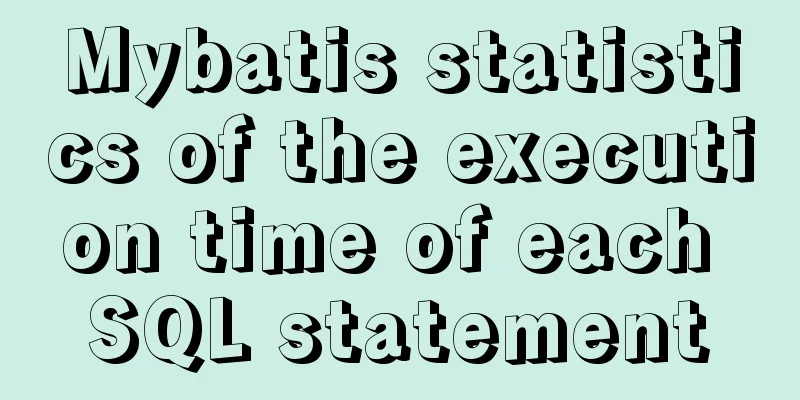Mybatis statistics of the execution time of each SQL statement

|
background I am often asked about database transactions in interviews recently. Usually I just know to add the annotation @Transactional and then I will be confused. Now I find that this part is really often overlooked, but interviewers like this kind of questions that are not often used but very important, so as to catch the interviewer off guard. No more nonsense, let’s get to the point. Solution 1: Aspect Programming @Aspect This solution mainly wraps the interface methods under the mapper package in a surrounding manner, and then calculates the time difference before and after. This is typical AOP knowledge. Although this calculation is rough, it is also a solution. The specific method is as follows:
@Aspect
@Component
@Slf4j
public class MapperAspect {
@AfterReturning("execution(* cn.xbmchina.mybatissqltime.mapper.*Mapper.*(..))")
public void logServiceAccess(JoinPoint joinPoint) {
log.info("Completed: " + joinPoint);
}
/**
* Monitor all public methods of cn.xbmchina.mybatissqltime.mapper..*Mapper package and its subpackages*/
@Pointcut("execution(* cn.xbmchina.mybatissqltime.mapper.*Mapper.*(..))")
private void pointCutMethod() {
}
/**
* Declaration around notification *
* @param pjp
* @return
* @throws Throwable
*/
@Around("pointCutMethod()")
public Object doAround(ProceedingJoinPoint pjp) throws Throwable {
long begin = System.nanoTime();
Object obj = pjp.proceed();
long end = System.nanoTime();
log.info("Calling Mapper method: {}, parameters: {}, execution time: {} nanoseconds, time consumed: {} milliseconds",
pjp.getSignature().toString(), Arrays.toString(pjp.getArgs()),
(end - begin), (end - begin) / 1000000);
return obj;
}
}
Solution 2: mybatis plugin MyBatis will have plug-ins intervene in the creation process of the four major objects. The plug-in can use the dynamic proxy mechanism to wrap the target object layer by layer, thereby achieving the effect of intercepting the target object before it executes the target method. MyBatis allows interception of calls at certain points during the execution of a mapped statement. By default, MyBatis allows plugins to intercept method calls including: ①Executor(update, query, flushStatements, commit, rollback, getTransaction, close, isClosed) Here is the code:
import org.apache.ibatis.executor.statement.StatementHandler;
import org.apache.ibatis.mapping.BoundSql;
import org.apache.ibatis.mapping.ParameterMapping;
import org.apache.ibatis.plugin.Interceptor;
import org.apache.ibatis.plugin.Intercepts;
import org.apache.ibatis.plugin.Invocation;
import org.apache.ibatis.plugin.Plugin;
import org.apache.ibatis.plugin.Signature;
import org.apache.ibatis.session.ResultHandler;
import org.slf4j.Logger;
import org.slf4j.LoggerFactory;
import org.springframework.stereotype.Component;
import java.sql.Statement;
import java.util.List;
import java.util.Properties;
/**
*Sql execution time recording interceptor*
* @author zero
* December 13, 2019 17:05:28
*/
@Intercepts({@Signature(type = StatementHandler.class, method = "query", args = {Statement.class, ResultHandler.class}),
@Signature(type = StatementHandler.class, method = "update", args = {Statement.class}),
@Signature(type = StatementHandler.class, method = "batch", args = {Statement.class})})
@Component
public class SqlExecuteTimeCountInterceptor implements Interceptor {
private static Logger logger = LoggerFactory.getLogger(SqlExecuteTimeCountInterceptor.class);
/**
* Maximum length of the printed parameter string */
private final static int MAX_PARAM_LENGTH = 50;
/**
* Maximum SQL length of the record */
private final static int MAX_SQL_LENGTH = 200;
@Override
public Object intercept(Invocation invocation) throws Throwable {
Object target = invocation.getTarget();
long startTime = System.currentTimeMillis();
StatementHandler statementHandler = (StatementHandler) target;
try {
return invocation.proceed();
finally
long endTime = System.currentTimeMillis();
long timeCount = endTime - startTime;
BoundSql boundSql = statementHandler.getBoundSql();
String sql = boundSql.getSql();
Object parameterObject = boundSql.getParameterObject();
List<ParameterMapping> parameterMappingList = boundSql.getParameterMappings();
// Format the SQL statement, remove line breaks, and replace parameters sql = formatSQL(sql, parameterObject, parameterMappingList);
logger.info("Execute SQL: [, {}] Execution time [{} ms]", sql, timeCount);
}
}
/**
* Format/beautify SQL statements*
* @param sql sql statement * @param parameterObject parameter Map
* @param parameterMappingList parameter List
* @return formatted SQL
*/
private String formatSQL(String sql, Object parameterObject, List<ParameterMapping> parameterMappingList) {
// Input sql string empty judgment if (sql == null || sql.length() == 0) {
return "";
}
// Beautify sql
sql = beautifySql(sql);
// In the scenario where no parameters are passed, just beautify the SQL and return it if (parameterObject == null || parameterMappingList == null || parameterMappingList.size() == 0) {
return sql;
}
return LimitSQLLength(sql);
}
/**
* Returns the SQL statement after the length limit*
*
* @param sql original SQL statement*/
private String LimitSQLLength(String sql) {
if (sql == null || sql.length() == 0) {
return "";
}
if (sql.length() > MAX_SQL_LENGTH) {
return sql.substring(0, MAX_SQL_LENGTH);
} else {
return sql;
}
}
@Override
public Object plugin(Object target) {
return Plugin.wrap(target, this);
}
@Override
public void setProperties(Properties properties) {
}
/**
* Replace the value corresponding to ? in SQL, only keep the first 50 characters*
* @param sql sql statement* @param valueOf ? corresponding value*/
private String replaceValue(String sql, String valueOf) {
//If there are more than 50 characters, only take the first 50 if (valueOf != null && valueOf.length() > MAX_PARAM_LENGTH) {
valueOf = valueOf.substring(0, MAX_PARAM_LENGTH);
}
sql = sql.replaceFirst("\\?", valueOf);
return sql;
}
/**
* Beautify SQL
*
* @param sql sql statement */
private String beautifySql(String sql) {
sql = sql.replaceAll("[\\s\n ]+", " ");
return sql;
}
} Solution 3: Use druid directly This is the type we use most often, but in an interview, just say it once, and I guess there is no need to ask it. The configuration application.yml file of Springboot+druid is as follows:
spring:
datasource:
url: jdbc:mysql://localhost:3306/testdb1?characterEncoding=utf-8&useUnicode=true&useSSL=false&serverTimezone=UTC
driver-class-name: com.mysql.jdbc.Driver # mysql8.0 and before used com.mysql.jdbc.Driver
Username: root
password: root
platform:mysql
#Through this configuration, the druid connection pool is introduced into our configuration. Spring will try its best to determine the type and then match the driver class according to the situation.
type: com.alibaba.druid.pool.DruidDataSource
druid:
initial-size: 5 # Initialization sizemin-idle: 5 # Minimummax-active: 100 # Maximummax-wait: 60000 # Configure the timeout for waiting to get the connectiontime-between-eviction-runs-millis: 60000 # Configure the interval for checking and detecting idle connections that need to be closed, in millisecondsmin-evictable-idle-time-millis: 300000 # Specify the minimum idle time for an idle connection to be cleared, in millisecondsvalidationQuery: select 'x'
test-while-idle: true # Whether to perform a connection test when the connection is idletest-on-borrow: false # Whether to test the connection when borrowing a connection from the connection pooltest-on-return: false # Whether to test the connection when it is returned to the connection poolfilters: config,wall,stat # Configure filters for monitoring statistics interception. After removing them, the monitoring interface sql cannot be counted. 'wall' is used for firewallpoolPreparedStatements: true # Turn on PSCache and specify the size of PSCache on each connectionmaxPoolPreparedStatementPerConnectionSize: 20
maxOpenPreparedStatements: 20
# Enable mergeSql function through connectProperties property; slow SQL record connectionProperties: druid.stat.slowSqlMillis=200;druid.stat.logSlowSql=true;config.decrypt=false
#Merge monitoring data from multiple DruidDataSources#use-global-data-source-stat: true
# WebStatFilter configuration, for instructions, please refer to Druid Wiki, Configuration_Configure WebStatFilter
web-stat-filter:
enabled: true #Whether to enable StatFilter. The default value is true.
url-pattern: /*
exclusions: /druid/*,*.js,*.gif,*.jpg,*.bmp,*.png,*.css,*.ico
session-stat-enable: true
session-stat-max-count: 10
#StatViewServlet configuration, please refer to Druid Wiki for instructions, configure_StatViewServletConfigure stat-view-servlet:
enabled: true #Whether to enable StatViewServlet. The default value is true.
url-pattern: /druid/*
reset-enable: true
login-username: admin
login-password: admin Summarize The above is the full content of this article. I hope it will be helpful for everyone’s study. I also hope that everyone will support 123WORDPRESS.COM. You may also be interested in:
|
<<: JS implements city list effect based on VUE component
>>: Detailed explanation of several ways to obtain the PID (TID, LWP) of Linux threads
Recommend
MySQL 5.7.16 free installation version installation and configuration method graphic tutorial
This article records the installation and configu...
Example code for CSS to achieve horizontal lines on both sides of the text
This article introduces the sample code of CSS to...
Four ways to compare JavaScript objects
Table of contents Preface Reference Comparison Ma...
Implementation of crawler Scrapy image created by dockerfile based on alpine
1. Download the alpine image [root@DockerBrian ~]...
Build Tomcat9 cluster through Nginx and realize session sharing
Use Nginx to build Tomcat9 cluster and Redis to r...
MySQL index failure principle
Table of contents 1. Reasons for index failure 2....
Complete steps to install boost library under linux
Preface The Boost library is a portable, source-c...
A brief discussion on the display modes of HTML tags (block-level tags, inline tags, inline block tags)
During today's lecture, I talked about the di...
A brief discussion on the problem of forgotten mysql password and login error
If you forget your MySQL login password, the solu...
Detailed explanation of KVM deployment of three virtual machines to implement WordPress experiment
1. Introduction to KVM The abbreviation of kernel...
Vue achieves the top effect through v-show
html <div class="totop" v-show="...
An example of dynamically implementing different styles of data in a column of el-table of element ui
Problem Description In the framework of Ele.me UI...
New ideas for time formatting in JavaScript toLocaleString()
Table of contents 1. Conventional ideas for time ...
Detailed explanation of the practical application of centos7 esxi6.7 template
1. Create a centos7.6 system and optimize the sys...
MySQL storage engine basics
In the previous article, we talked about MySQL tr...









